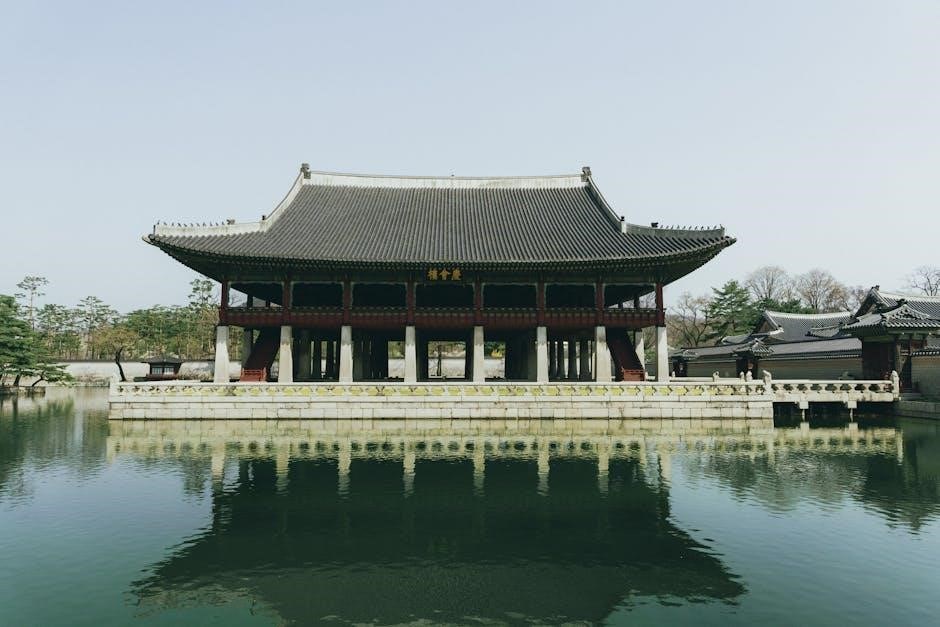South Korea captivates visitors with its vibrant cities‚ stunning natural landscapes‚ and rich cultural heritage‚ offering a blend of modernity and tradition that defines this captivating destination.
Overview of South Korea’s Geography and Culture
South Korea‚ a peninsula in East Asia‚ boasts a diverse geography with lush mountains‚ pristine coastlines‚ and vibrant cities. Its culture is a harmonious blend of traditional values and modern innovations‚ reflected in its festivals‚ cuisine‚ and etiquette. The country’s natural beauty‚ from scenic Jeju Island to the bustling streets of Seoul‚ offers endless exploration opportunities‚ making it a destination that seamlessly intertwines history‚ nature‚ and contemporary life.
Best Time to Visit South Korea
South Korea’s ideal travel seasons are spring (March–May) and autumn (September–November)‚ offering mild weather and vibrant landscapes. Spring highlights cherry blossoms‚ while autumn showcases stunning foliage. Summer (June–August) is warm but humid‚ perfect for beach destinations like Busan and Jeju Island. Winters (December–February) are cold but feature unique experiences like snow festivals and hot springs. Plan your visit according to your preferences for nature‚ culture‚ or outdoor activities.
Essential Travel Tips for First-Time Visitors
First-time visitors to South Korea should learn basic Korean phrases‚ as English is limited outside major cities. Carry a T-money card for easy public transport and download navigation apps like Naver Maps. Respect local customs‚ such as removing shoes indoors and using chopsticks correctly. Plan ahead for popular attractions and consider guided tours for a seamless experience. Don’t miss trying street food and local markets for an authentic taste of Korean culture.
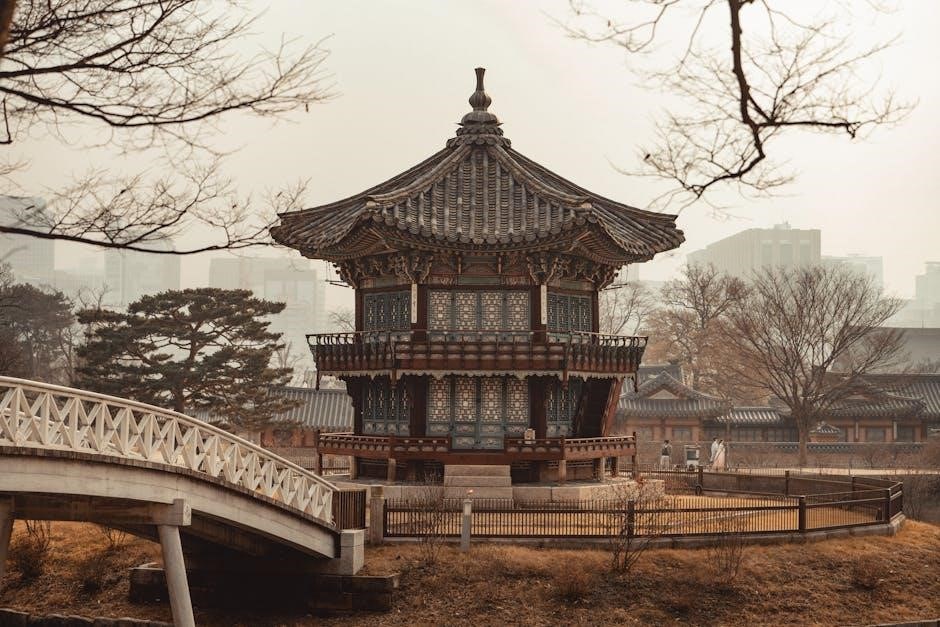
Exploring Seoul
Seoul captivates with its vibrant blend of tradition and modernity‚ offering iconic landmarks like Gyeongbokgung Palace and bustling districts such as Myeongdong‚ where historic charm meets contemporary culture.
Must-Visit Landmarks in Seoul
Seoul’s landmarks showcase its rich history and vibrant culture. Gyeongbokgung Palace‚ the largest royal palace‚ offers a glimpse into Joseon Dynasty splendor. Bukchon Hanok Village preserves traditional Korean architecture‚ while Myeongdong captivates with its bustling energy and shopping. The iconic N Seoul Tower provides panoramic city views‚ and Hongdae and Itaewon highlight Seoul’s modern‚ eclectic vibe. These landmarks blend tradition and innovation‚ making Seoul a fascinating destination for every traveler.
Best Places to Stay in Seoul
Seoul offers diverse accommodations to suit every traveler’s needs. Hongdae and Gangnam are ideal for vibrant nightlife and trendy vibes‚ while Myeongdong and Itaewon provide convenient access to shopping and dining. For a traditional experience‚ Jongno’s hanok guesthouses offer a cultural stay. Luxurious hotels like Four Seasons and The Shilla cater to upscale travelers‚ while budget-friendly options in Sejongno and Namsan are perfect for those exploring on a budget. Seoul’s diverse neighborhoods ensure a memorable stay for all visitors.
Seoul’s Food and Nightlife Scene
Seoul’s culinary scene is a paradise for food lovers‚ offering a mix of traditional and modern flavors. Savor iconic dishes like tteokbokki‚ bibimbap‚ and hotteok at street food markets such as Myeongdong Night Market and Gwangjang Market. For nightlife‚ explore Hongdae’s trendy bars‚ Itaewon’s international pubs‚ and Gangnam’s upscale clubs. Don’t miss the unique pojangmacha (street bars) for a local drinking experience. Seoul’s dynamic food and nightlife scene promises unforgettable adventures for every visitor.

Discovering Busan
Busan captivates with its stunning beaches‚ vibrant markets‚ and rich cultural heritage‚ offering a unique blend of traditional temples‚ fresh seafood‚ and lively nightlife along its scenic coastline.
Top Attractions in Busan
Busan boasts a wealth of iconic attractions that showcase its natural beauty and cultural richness. Visit the serene Haedong Yonggungsa Temple‚ nestled by the ocean‚ and explore the vibrant Gamcheon Culture Village‚ known for its colorful houses and artistic vibe. Don’t miss Taejongdae‚ a scenic coastal park with stunning views‚ and Jagalchi Fish Market‚ where you can experience the freshest seafood. These landmarks offer a perfect blend of spirituality‚ culture‚ and natural splendor‚ making Busan a must-visit destination.
Where to Eat in Busan
Busan is a food lover’s paradise‚ offering a diverse culinary experience. Head to Jagalchi Fish Market for the freshest seafood‚ where you can savor raw fish and other ocean delicacies. Explore Gukje Market for street food treats like hotteok (sweet pancakes) and bibimbap. Don’t miss Haeundae Beach restaurants for grilled clams and abalone. For a unique dining experience‚ visit Geumsujae for traditional Korean dishes. Busan’s vibrant food scene promises unforgettable flavors and local specialties.
Unique Experiences in Busan
Busan offers a variety of unique experiences that showcase its vibrant culture and natural beauty. Visit the Haedong Yonggungsa Temple for a serene sunrise over the ocean. Explore the colorful Gamcheon Culture Village‚ known for its artistic murals and quirky shops. Stroll along Cheongsapo for breathtaking sunsets and coastal views. Don’t miss the chance to relax at Haeundae Beach or take a scenic hike at Ahopsan Forest. These experiences capture the essence of Busan’s charm and diversity.
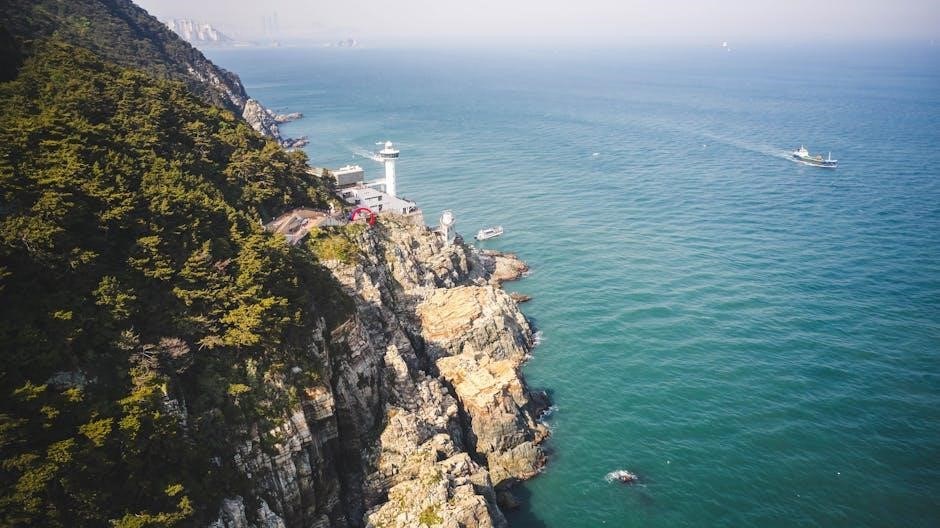
Visiting Jeju Island
Jeju Island‚ a UNESCO World Heritage Site‚ offers a unique blend of natural beauty and cultural richness. Located off South Korea’s southern coast‚ it features lush green countryside‚ stunning coastlines‚ and unique volcanic landscapes that captivate visitors. The island’s distinct dialect‚ traditions‚ and tempting local dishes make it a perfect getaway for exploration and relaxation.
Natural Wonders of Jeju Island
Jeju Island‚ a UNESCO World Heritage Site‚ is renowned for its breathtaking natural wonders. The iconic Seongsan Ilchulbong Sunrise Peak‚ a majestic volcanic crater‚ and the Manjanggul Lava Tube‚ one of the world’s longest‚ are must-visit attractions. The island’s lush green countryside‚ stunning waterfalls‚ and picturesque beaches create a diverse and enchanting landscape. Hallasan Mountain‚ the highest peak in South Korea‚ offers a challenging yet rewarding hike‚ while the Jeju Olle Trail provides a serene way to explore the island’s coastal beauty.
Best Places to Stay on Jeju Island
Jeju Island offers a wide range of accommodations to suit every traveler’s needs. From luxury resorts like the Shinhwa Jeju Shinhwa World Hotels & Resorts to boutique hotels with ocean views‚ visitors can enjoy a comfortable stay. Budget-friendly guesthouses and pensions are also available‚ offering a cozy atmosphere. Many accommodations are strategically located near popular attractions like Seongsan Ilchulbong and Hallasan Mountain‚ making it easy to explore the island’s natural wonders. Choose a place that matches your style and preferences for an unforgettable stay.
Hidden Gems of Jeju Island
Jeju Island is a treasure trove of hidden gems beyond its famous landmarks. Explore the serene Jeju Folklore and Natural History Museum to uncover the island’s cultural heritage. Visit the lesser-known O’Sulloc Tea Museum‚ nestled in lush green tea fields‚ offering a unique tea-tasting experience. Discover the tranquil Seopjikoji Cliffs‚ a lesser-visited coastal area with dramatic ocean views. For a peaceful retreat‚ head to Songaksan Mountain‚ where you can hike and enjoy breathtaking sunsets. These hidden spots offer a deeper connection to Jeju’s natural beauty and culture.

Day Trips and Short Excursions
Discover South Korea’s diverse landscapes and culture through day trips to the DMZ‚ Gyeongju’s historical sites‚ and scenic countryside‚ offering a mix of history‚ nature‚ and relaxation.
Day Trip to the DMZ
A day trip to the DMZ offers a unique glimpse into South Korea’s history and geopolitical landscape. Visit the Third Infiltration Tunnel‚ Dora Observatory‚ and Freedom Bridge‚ learning about the Korean War and ongoing tensions. Guided tours provide insight into the region’s significance‚ while the stark contrast between the heavily fortified border and surrounding peaceful countryside leaves a lasting impression. This excursion is a must for history enthusiasts seeking to understand the complexities of the Korean Peninsula.
Exploring Gyeongju’s Historical Sites
Gyeongju‚ the ancient capital of the Silla Kingdom‚ is a treasure trove of historical wonders. Visit Bulguksa Temple‚ a UNESCO World Heritage Site‚ and marvel at its intricate architecture. Explore the nearby Seokguram Grotto‚ home to a serene Buddha statue. Wander through the Daereungwon Tomb Complex‚ where kings lie buried beneath grassy mounds. The Gyeongju National Museum offers deeper insights into the city’s rich past‚ making it an essential stop for history enthusiasts seeking to uncover South Korea’s cultural heritage.
Short Excursions from Seoul
Seoul’s surrounding regions offer countless opportunities for memorable day trips. Visit the Demilitarized Zone (DMZ) to explore the tension-filled border with North Korea. Discover the scenic beauty of Namhansanseong Fortress‚ a UNESCO World Heritage Site‚ or head to Paju for its vibrant art scene. For a cultural experience‚ travel to Gwangjang Market in Seoul to savor traditional street food. These excursions provide a perfect blend of history‚ nature‚ and culture‚ making them ideal for those seeking to explore beyond the city limits.
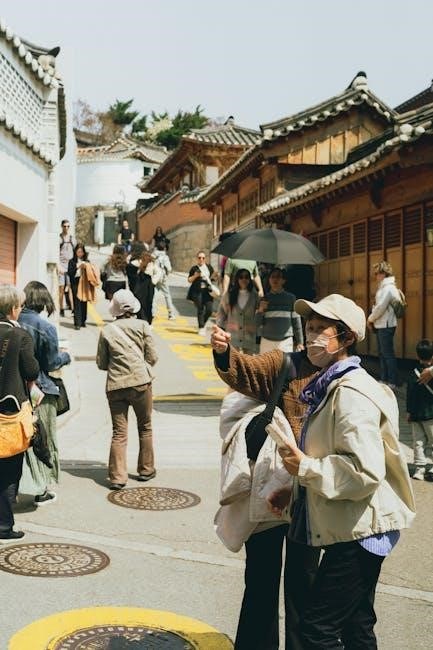
Seasonal Itineraries
South Korea’s seasonal beauty offers tailored experiences: cherry blossoms in spring‚ vibrant autumn foliage‚ and winter sports‚ each providing unique ways to explore the country’s diverse charm.
Cherry Blossom Spots in South Korea
South Korea’s cherry blossom season is a breathtaking spectacle‚ typically occurring from late March to early April. Jinhae’s Gunhangje Festival is a must-visit‚ featuring stunning pink blooms along the coast. Busan’s Gyeongungdae area transforms into a floral paradise‚ while Jeju Island offers unique cherry blossom trails. In Seoul‚ spots like the Han River and Namsan Park showcase vibrant displays. Plan your visit during peak blooms for an unforgettable experience amidst nature’s beauty.
Autumn Foliage in South Korea
South Korea’s autumn foliage is a kaleidoscope of vibrant colors‚ with leaves turning golden‚ orange‚ and red from late October to early November. Seoraksan National Park offers breathtaking mountain vistas‚ while Gyeongju’s Bulguksa Temple is surrounded by stunning fall hues. In Seoul‚ Namsan Park and the Han River are popular spots to enjoy the season. The cooler weather makes it ideal for hiking‚ photography‚ and immersing in nature’s beauty‚ creating unforgettable memories during your visit.
Winter Activities in South Korea
South Korea’s winters offer a variety of exciting activities‚ from skiing at Everland Theme Park to ice fishing festivals. Vivaldi Park in Hongcheon is a top destination for snowboarding and winter sports. The DMZ also offers unique winter tours‚ showcasing serene landscapes. Ice skating rinks in Seoul‚ such as the one at Lotte World‚ provide fun for all ages. Don’t miss the Hwacheon Sancheoneo Ice Festival‚ featuring ice sculptures and trout fishing. Winter in South Korea is a season of adventure and cultural charm.
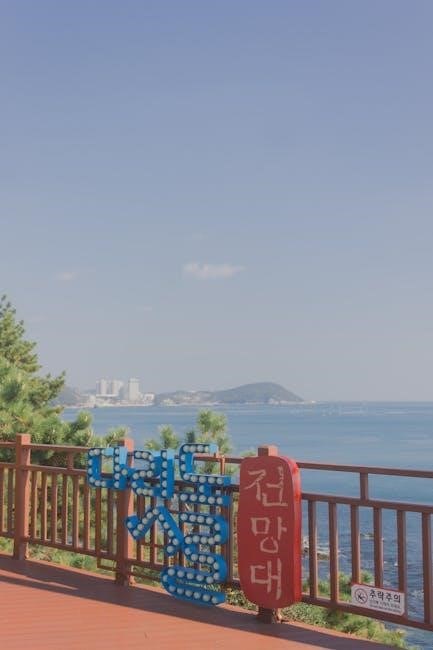
South Korea’s Culinary Delights
South Korea’s cuisine is a vibrant blend of bold flavors‚ spices‚ and fresh ingredients. From sizzling street food markets to high-end restaurants‚ the country offers a diverse culinary experience. Popular dishes like kimchi‚ bibimbap‚ and bulgogi showcase the nation’s rich gastronomic heritage. Festivals and food tours provide opportunities to explore regional specialties‚ while modern twists on traditional recipes continue to captivate food enthusiasts worldwide. South Korea’s culinary scene is a delightful journey of flavors and traditions.
Street Food Markets in South Korea
South Korea’s street food markets are a culinary paradise‚ offering a diverse array of flavors and dishes. Myeongdong Street Food Market in Seoul is a must-visit‚ featuring popular snacks like tteokbokki and hotteok. Gwangjang Market is another iconic spot‚ known for its bindaetteok (Korean pancake) and mayak kimbap. Jagalchi Fish Market in Busan provides fresh seafood options‚ while night markets like Bupyeong in Busan offer a lively atmosphere with grilled delights. These markets are a testament to South Korea’s vibrant food culture‚ blending tradition and innovation.
Traditional Korean Dishes to Try
South Korea’s culinary landscape is rich and diverse‚ with dishes that highlight local ingredients and bold flavors. Kimchi‚ a fermented cabbage dish‚ is a staple‚ while bibimbap offers a colorful mix of rice‚ vegetables‚ and meat. Bulgogi‚ marinated beef‚ showcases Korean grilling expertise‚ and tteokbokki‚ chewy rice cakes in spicy sauce‚ is a favorite street food. Jajangmyeon‚ black bean noodles‚ and samgyeopsal‚ grilled pork belly‚ are must-tries. These dishes reflect Korea’s balance of flavor and tradition.
Best Restaurants in South Korea
South Korea boasts a vibrant dining scene‚ with restaurants offering a mix of traditional and modern cuisine. From Michelin-starred eateries to cozy local spots‚ there’s something for every palate. In Seoul‚ restaurants like L’Effervescence and Onjium blend Korean flavors with international techniques. Busan’s Jagalchi Fish Market serves fresh seafood‚ while Jeju Black Pork Street specializes in the island’s famous black pork. These restaurants offer a taste of Korea’s culinary excellence and cultural richness.
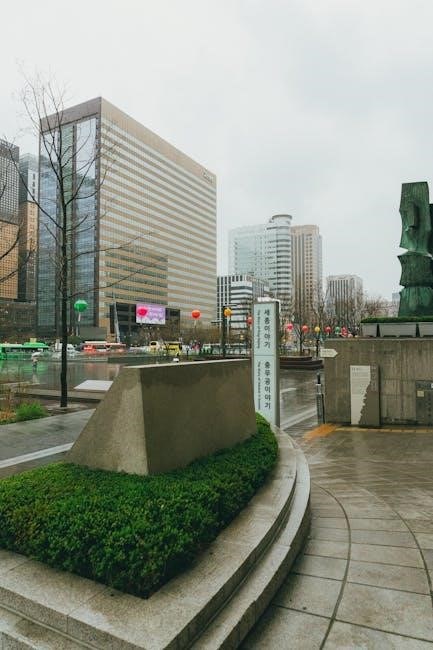
Shopping in South Korea
South Korea offers a vibrant shopping experience‚ blending high-end luxury and traditional markets. From Seoul’s Myeongdong to Busan’s Gukje Market‚ shoppers can explore a wide range of styles.
Popular Shopping Districts in Seoul
Seoul offers a diverse shopping experience‚ with districts catering to every style and budget. Myeongdong is renowned for its bustling streets filled with cosmetics‚ fashion‚ and street food. Hongdae attracts younger crowds with its indie shops and trendy boutiques. Gangnam‚ famous for its luxury brands and high-end malls‚ is a hotspot for affluent shoppers. Each district reflects Seoul’s vibrant energy‚ making it a paradise for shopaholics and explorers alike.
Best Markets for Souvenirs
South Korea’s vibrant markets are perfect for souvenir shopping. Gwangjang Market in Seoul offers traditional snacks and handmade crafts‚ while Namdaemun Market is ideal for affordable souvenirs like Korean clothing and accessories. Myeongdong Night Market is a must-visit for K-beauty products and trendy items. Insadong’s traditional tea houses and shops specialize in Korean art‚ pottery‚ and hanji (traditional paper) goods‚ making these markets a shopper’s paradise for authentic Korean souvenirs.
Luxury Shopping in South Korea
South Korea offers a sophisticated luxury shopping experience‚ particularly in Seoul. Cheongdam-dong and Apgujeong are renowned for high-end boutiques featuring global designer brands. Department stores like Shinsegae‚ Hyundai‚ and Lotte cater to affluent shoppers with premium products. The COEX Mall in Gangnam is another hub for luxury retail‚ offering a refined atmosphere and personalized service. These destinations are perfect for travelers seeking exclusive brands‚ elegant designs‚ and a touch of Korean sophistication in their shopping experience.
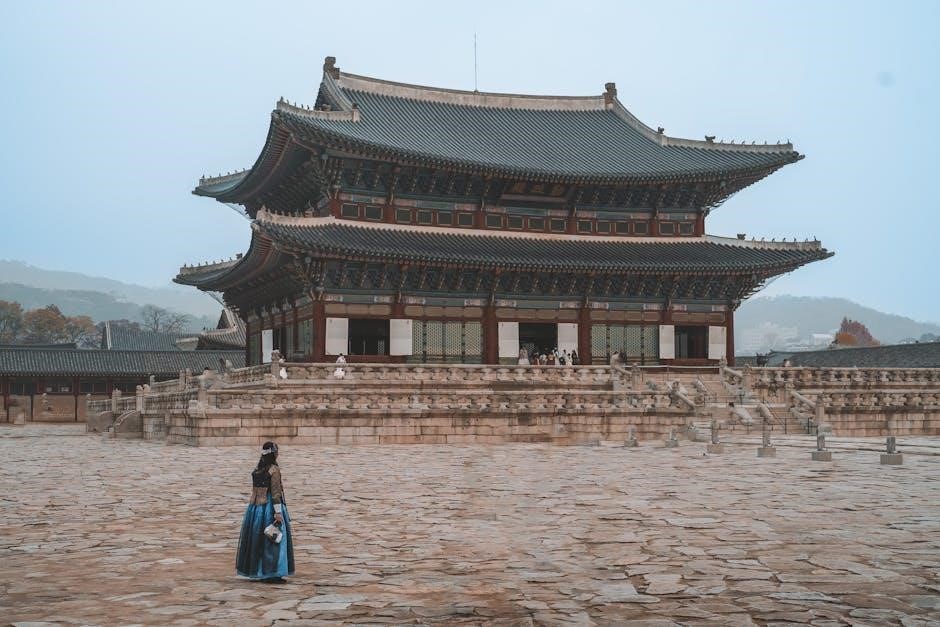
Cultural and Historical Insights
South Korea seamlessly blends ancient traditions with modern innovation‚ offering a rich tapestry of cultural festivals‚ historical sites‚ and vibrant traditions that reflect its resilient heritage.
South Korea’s Rich History
South Korea’s history is a captivating journey through ancient kingdoms‚ colonial resilience‚ and modern transformation. From the Joseon Dynasty’s enduring legacy to the division of the peninsula‚ the country’s past is etched in landmarks like Gyeongbokgung Palace and Jogyesa Temple. Historical sites such as Bukchon Hanok Village and Gyeongju’s tombs reveal a deep cultural heritage. The DMZ serves as a poignant reminder of the nation’s turbulent recent history‚ blending ancient traditions with a complex modern identity.
Cultural Festivals and Events
South Korea’s cultural festivals and events showcase its vibrant traditions and modern spirit. The Cherry Blossom Festival delights with stunning blooms‚ while autumn foliage highlights natural beauty. Winter activities‚ like skiing‚ offer unique experiences. Festivals such as the Lotus Lantern Festival and Boryeong Mud Festival blend tradition with fun. These events reflect South Korea’s dynamic identity‚ offering visitors a chance to immerse themselves in local culture‚ food‚ and celebrations that highlight the country’s rich heritage and contemporary vibrancy.
Traditional Korean Etiquette
Respecting traditional Korean etiquette enhances cultural interactions. Bowing is a common greeting‚ with depth reflecting respect. Removing shoes before entering homes or traditional buildings is customary. Using chopsticks correctly and avoiding finishing a meal completely are polite practices. Older individuals are highly respected‚ and using formal language is appreciated. Understanding these customs helps visitors connect deeply with Korean culture and show appreciation for its timeless traditions and values.
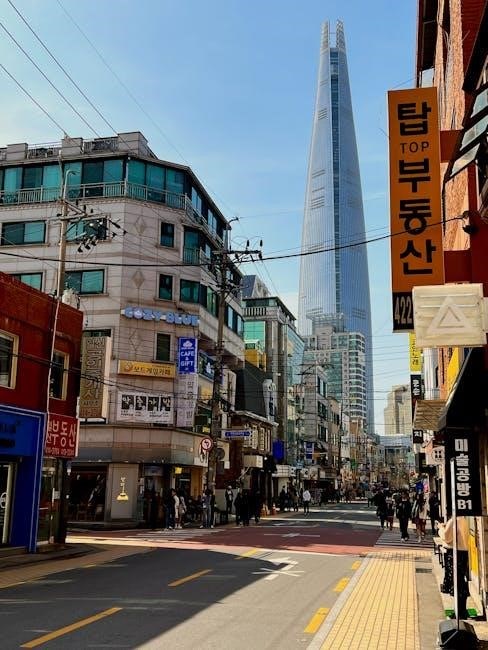
Tips for First-Time Visitors
Plan ahead‚ download transportation apps like Naver Maps‚ learn basic Korean phrases‚ and respect local customs for a seamless and enriching South Korea experience.
Language and Communication
While Korean is the primary language‚ many younger individuals and service staff in tourist areas speak English. Learning basic phrases like “annyeonghaseyo” (hello) and “gamsahamnida” (thank you) can enhance your experience. Download translation apps like Naver Translate for real-time assistance‚ especially when navigating menus or public transport. Carry a business card or write down destinations in Korean to help taxi drivers. Don’t hesitate to ask locals for help—they’re often eager to assist foreigners.
Navigation and Transportation
South Korea boasts an efficient transportation network‚ with subways‚ buses‚ and taxis connecting major cities. Seoul’s comprehensive subway system is a traveler’s best friend‚ while express buses link cities like Busan and Jeju. The KTX high-speed train offers rapid intercity travel. T-money cards simplify public transport payments. Ride-hailing apps like KakaoTalk Taxi are widely used. GPS navigation apps like Naver Maps are indispensable for directions. English signage is common‚ making it relatively easy for foreigners to navigate.
Respecting Local Customs
Respecting local customs is key to a harmonious experience in South Korea. Bowing is a common greeting‚ and removing shoes indoors is expected. Table manners‚ such as not finishing a meal completely‚ show respect. Elders are highly revered‚ so offering your seat or using polite language is appreciated. During festivals‚ dress modestly and follow temple etiquette. Understanding these customs enhances your cultural immersion and fosters positive interactions with locals.
